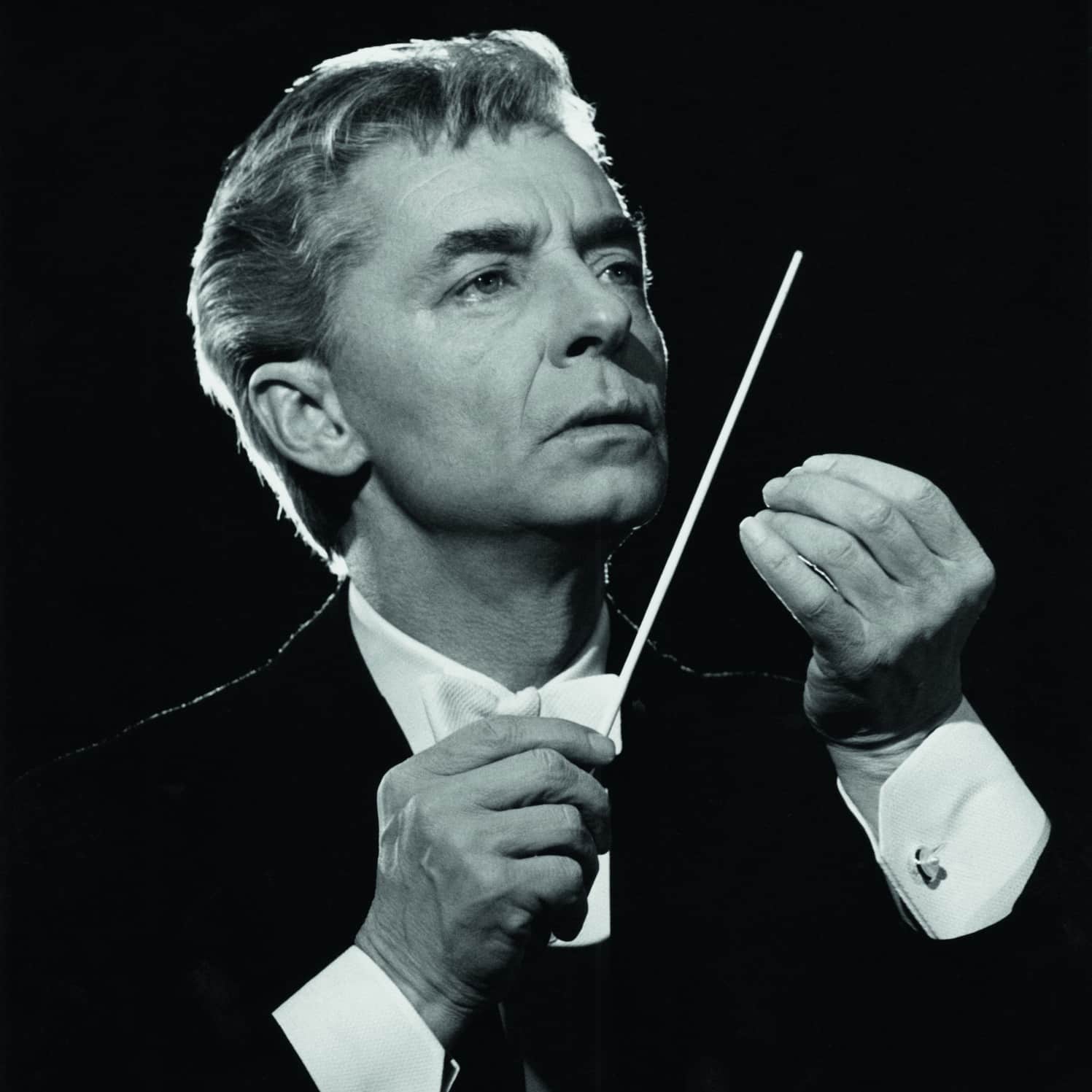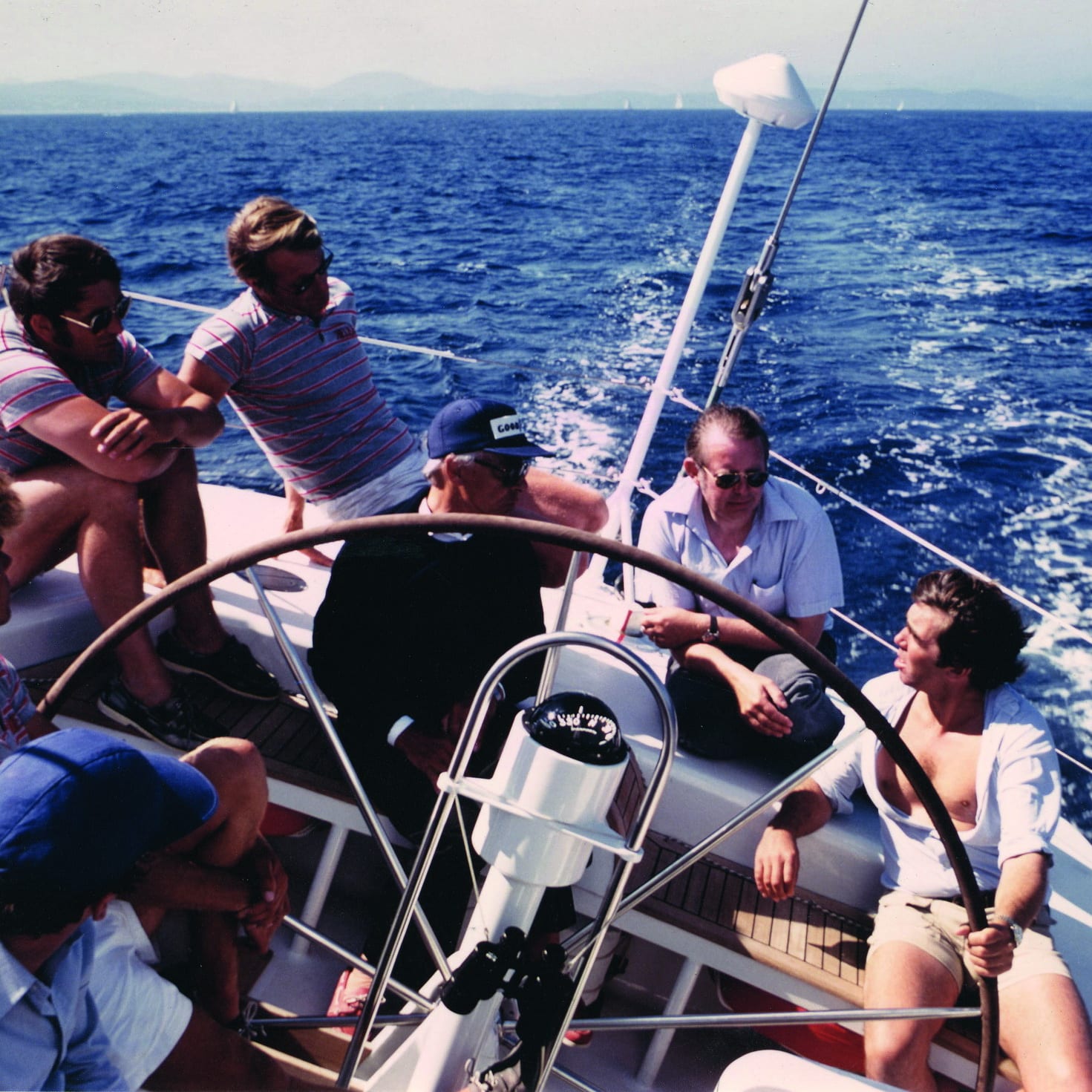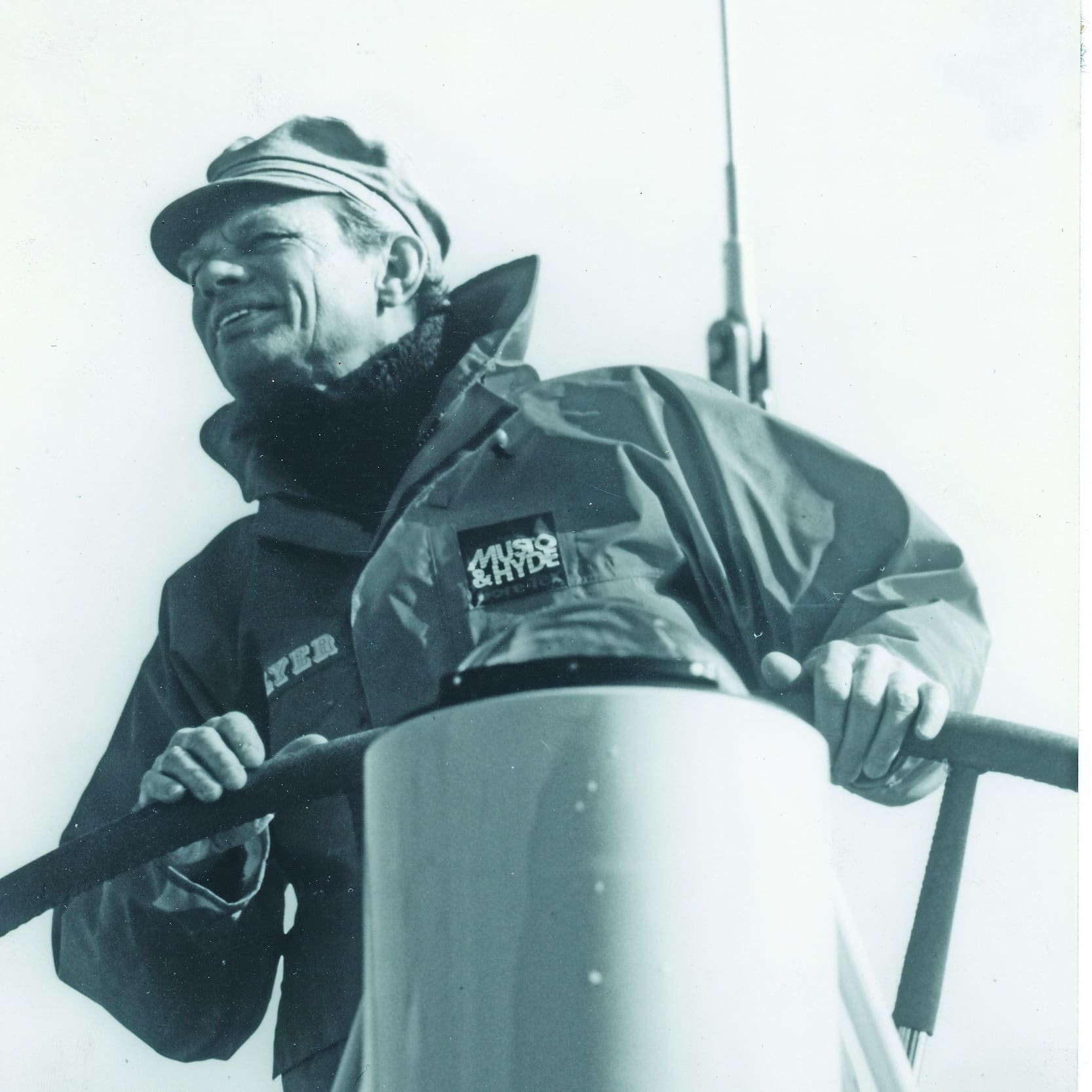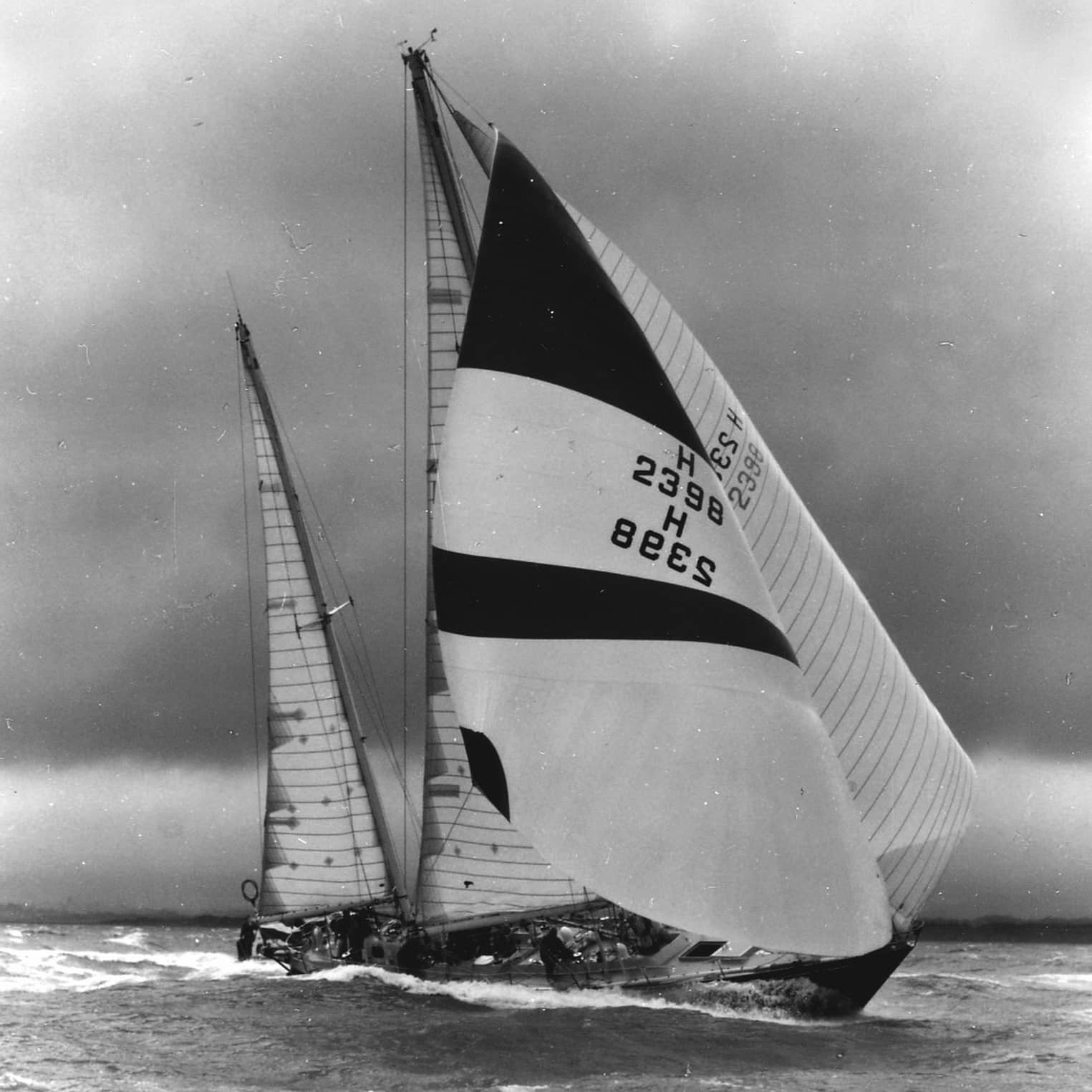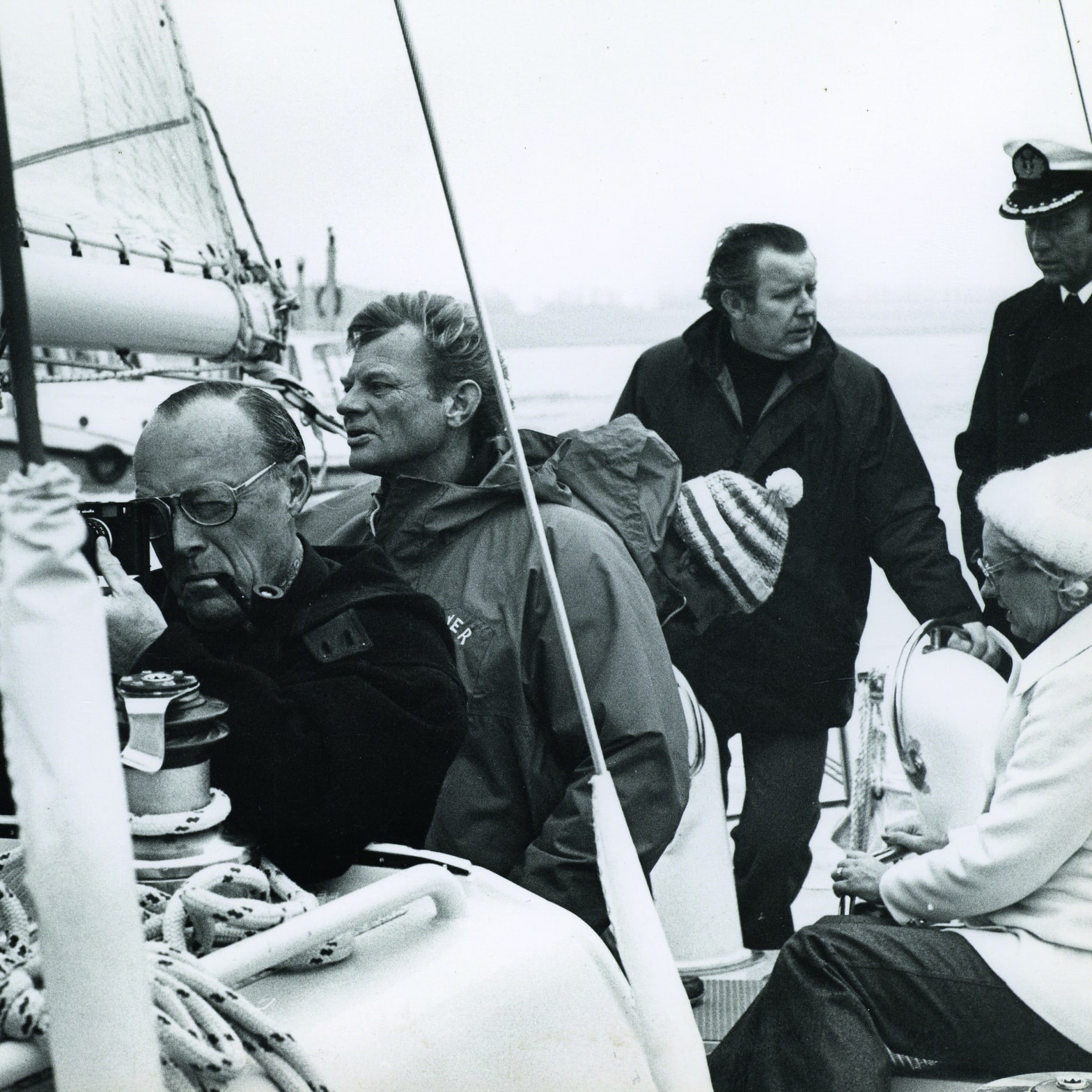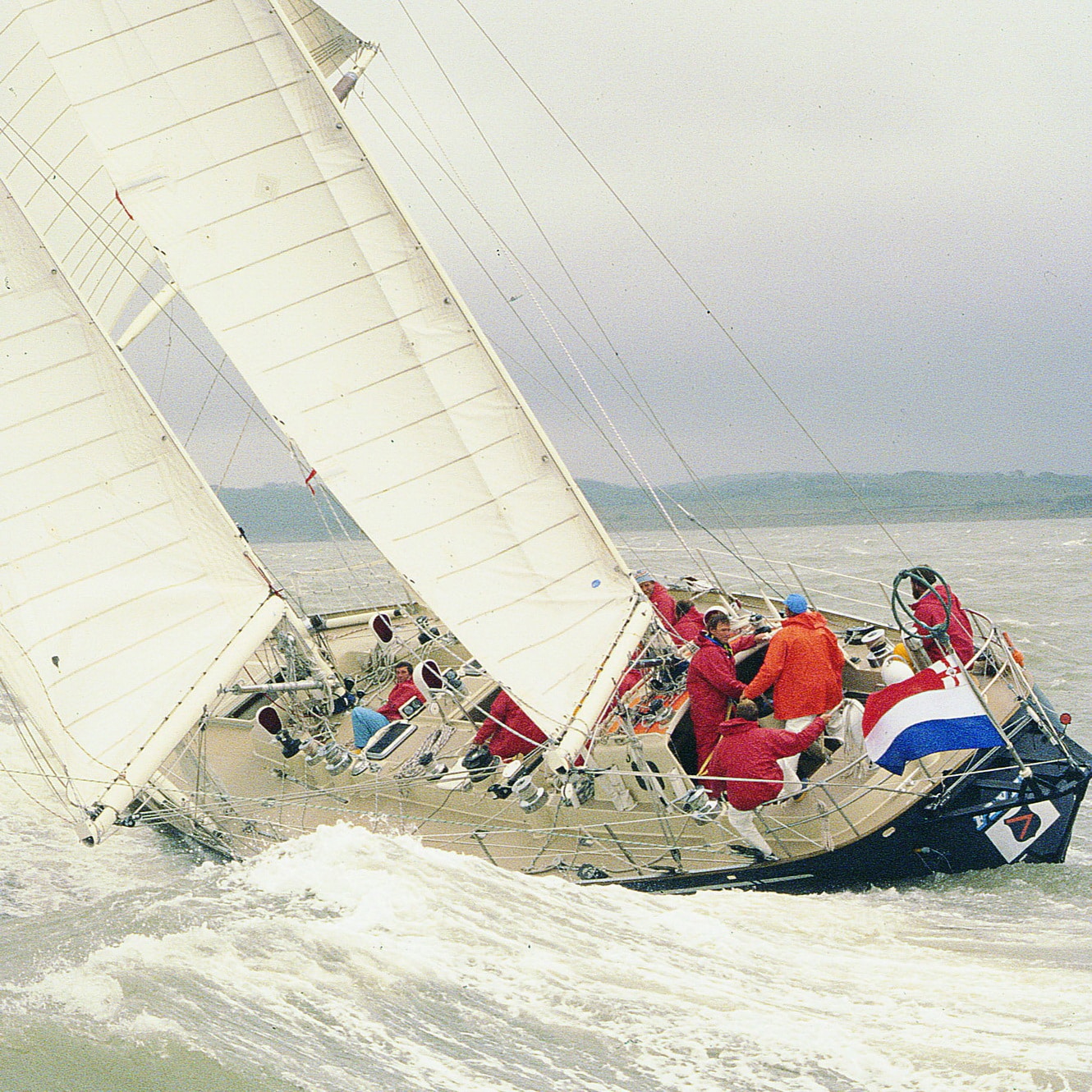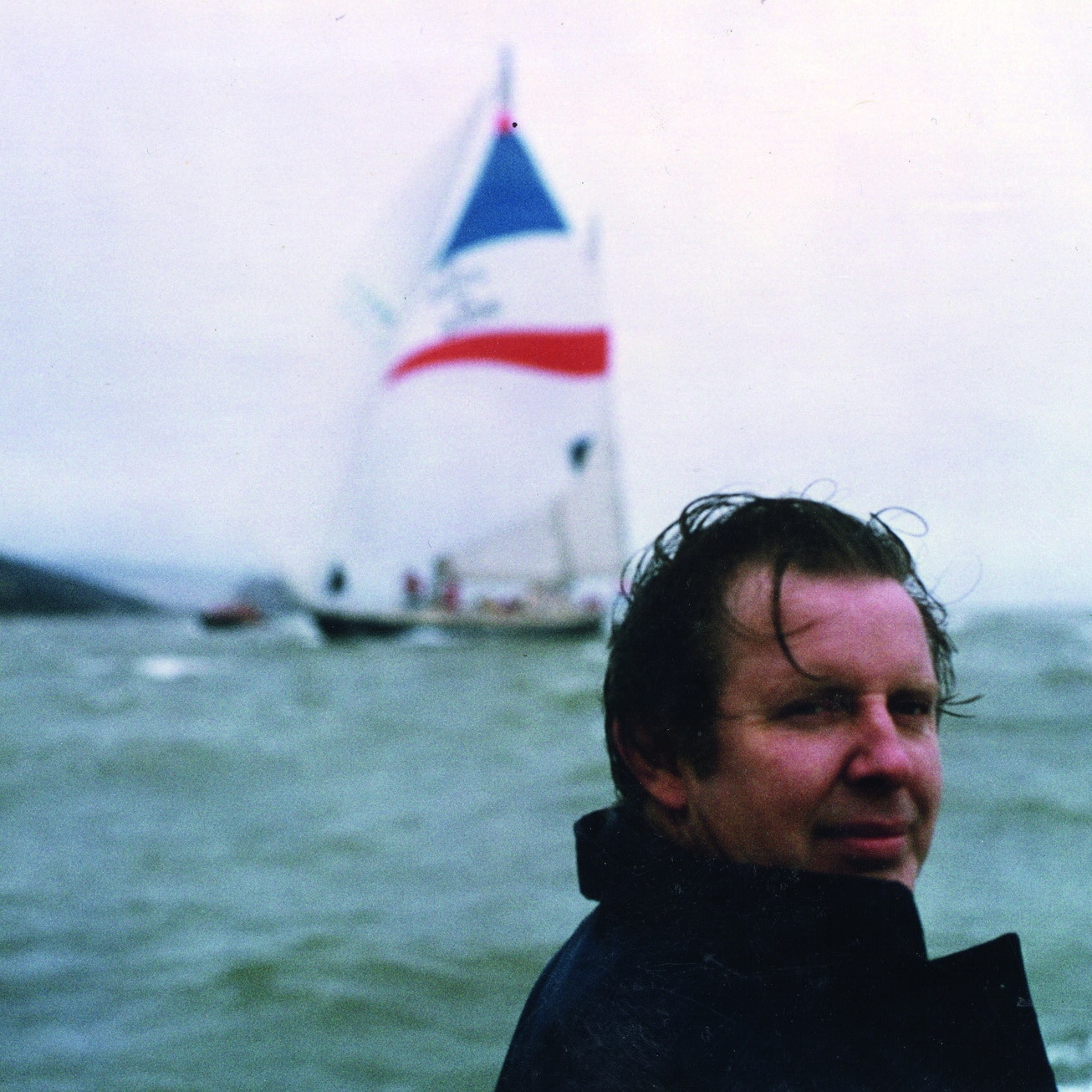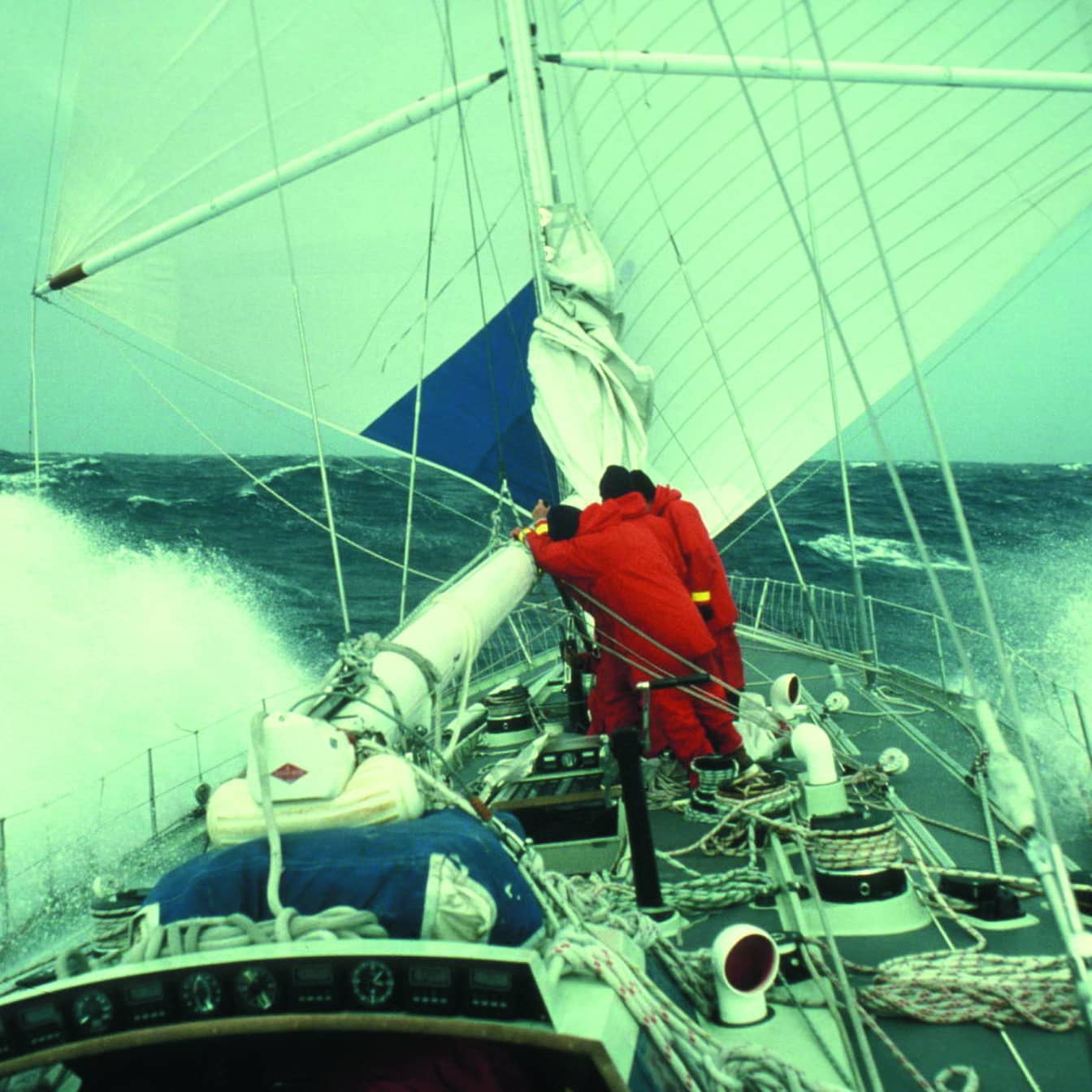Part 4 of “Ready about! – The racing years”
THE MAXIS AND THE FLYER CAMPAIGNS
THE MAXIS AND THE FLYER CAMPAIGNS
10 MIN READ
Her owner, “Il Maestro” Herbert von Karajan, was the world-renowned leader of the famous Berlin Philharmonic Orchestra and could be every bit as mercurial as might be expected of someone who was so widely feted and driven by such artistic passions. He made it clear to Wolter Huisman that the touch and movement of the wheel to his artistic fingertips would be the true test of the quality of the build. True to his word, as soon as Helisara was launched, Von Karajan stepped into the cockpit, placed a single digit at the top of the wheel and, using friction only, moved the wheel to port and to starboard before nodding appreciatively: “Excellent, I’m happy to accept her.” No further inspection was required.
Main photo on top: With a little help from top American sailor Gary Jobson, Von Karajan’s Frers-designed Helisara won the Maxi Worlds at Porto Cervo in 1981. Right: “Il Maestro” – Herbert von Karajan was the world’s most celebrated orchestra conductor in his time.
At a more technical level, Helisara was the first Huisman yacht to incorporate new, lightweight construction techniques. They were initiated between her designer, Germán Frers, and Wolter Huisman and involved the use of very strong but light aluminium extrusions in the hull structure and veneered honeycomb bulkheads for the interior. Helisara enjoyed her successes but, perhaps, did not reach her full potential because she was not sailed as aggressively as the arch-rival of all Maxi competitors, Jim Kilroy’s Kialoa.
Helisara’s real claim to fame is as the inspiration and template for Flyer II, but first the story must unwind a few years to the genesis of the original Flyer, winner of the 1977–1978 Whitbread Round the World Race.
Read more about Helisara and Herbert van Karajan on this website > inhuis stories & updates [link]
Left: Von Karajan, Wolter Huisman and Germán Frers aboard Helisara. Below: Conny van Rietschoten – a great sailor, organiser and crew leader.
When newspaper reports of the first Whitbread Race appeared during 1973–1974, Cornelis (Conny) van Rietschoten took a particular interest. He came from a long line of seafarers whose family had eventually moved into fitting out sailing ships in Rotterdam and then diversified into other profitable areas of business. As a child he experienced a privileged background during the 1920s and 1930s: one in which sailing was always central to family activities. Then, with shocking abruptness, all of this changed. War broke out, two of his brothers were killed and Conny had to go into hiding, subsisting close to starvation on any scraps he could find for months on end.
When the war ended, the family survivors began to pick up the pieces; Conny returned to sailing and was introduced to the family business. He excelled at both. At the age of twenty-two, he sailed an open Dragon with his friend Morin Scott from England to Norway in constant gales to compete in the Dragon World Championship. The pair were too exhausted and the boat too shot by the pounding it had taken for any real chance of racing success, but the king of Norway awarded them a special prize for their navigational feat, proclaiming them the best sailors of the regatta. Cowes Weeks and Fastnet Races followed, but then a combination of illness and business pressures came between Van Rietschoten and sailing, that is until he saw the Whitbread Race newspaper articles some fifteen years later.
Conny had just sold the business and, as a financially independent, now fully fit forty-eight-year-old, he was looking for something new to do. The next Whitbread Race looked like the perfect answer. He was impressed that the winning yacht in 1974, Sayula, had been a production Swan 65 and felt, instinctively, that a development of this design made more sense than some of the Maxis that were lining up for the next event. Conny van Rietschoten’s greatest strength – besides his seamanship – was that he was a meticulously thorough researcher, planner and organiser. After a wide range of consultations, he asked Sparkman & Stephens to design him an optimised 65 footer for the race, and he placed an order with the Huisman Shipyard to build it – on condition that it would be ready to sail away on the fi rst Saturday in April, 1977 (such was his precision). In fact, Flyer was completed a few days ahead of schedule and, to quote Van Rietschoten and Barry Pickthall from their book Flyer: “… all the credit for this should go to Wolter Huisman, who did an excellent job. She was extremely well built and never presented worrying symptoms of structural weakness, which appeared on several other boats in the race.”
Although the hull lines were similar to those of the Swan 65, just about everything else differed. Conny had extensive discussions with Sayula’s owner, Ramon Carlin, his crew and other competitors from the first race to find out what worked and what did not. This resulted in innovative deck layouts and features for boat and sail handling, exceptional crew and galley amenities, and carefully planned deck space below for sail packing. Between her launch and the start of the race, Flyer sailed 10,000 miles, including sea trials, a carefully planned cruise to the United States and participation in the Transatlantic Race on the way back. Wolter Huisman and his team were on standby to implement whatever changes might result from this comprehensive shakedown and, after their efforts, there can be no question that Flyer was by far the most thoroughly prepared yacht on the start line.
Left: Flyer was fast downwind, but it was not her happiest point of sailing. Below: Prince Bernhard of the Netherlands, Conny van Rietschoten and Wolter Huisman aboard Flyer.
With an outstanding crew that included the highly experienced watch leaders Aedgard Koekebakker and Gerard Dijkstra (who also navigated), Van Rietschoten and Flyer took the first leg to Cape Town by storm, winning line honours over the much larger Maxi yachts and easily winning the first leg on handicap. The duels of the next three legs were tough, but seamanship, preparedness and a very strong boat prevailed, and at 15:08 GMT on 25 March 1978, Flyer crossed the line – witnessed by a jubilant Wolter Huisman – to take the overall prize.
A storming finish
The watch leaders of Flyer have provided some interesting stories from the race, including a massive broach during big winds and seas in the Southern Ocean after a steering cable snapped, and a terrifying Chinese gybe in the Straits of Le Maire just after they rounded Cape Horn. With little room to manoeuvre, Flyer had to run dead downwind (which she hated), and in a big blast of wind she gybed all standing, breaking the spinnaker pole and ending up pinned down on her beam ends. Dijkstra vividly recalls “having to climb up a wet deck like a vertical rock face to release the sheets”.
But all those onboard agreed that, notwithstanding anything the Southern Ocean could throw at them, nothing had quite prepared them for the final 60 miles to the finish in the English Channel and Solent. With the wind a constant gale and gusting to hurricane force, Flyer blew her 2.2 oz heavy spinnaker as she raged in through the Needles Channel; the crew were forced to cut the tack of the shooter in order to lower it as she rolled from gunwale to gunwale in high standing waves; and Dijkstra recalls being fixated by the alarming bend in the spinnaker pole that extended the jib, convinced it would shatter at any moment. Quite a finish!
Cornelis van Rietschoten became a Dutch national hero (and an international sailing hero) for this mighty exploit. Furthermore, the benefits arising from his intelligent planning and unusually enlightened consideration for the well-being and harmony of the crew – ashore as well as at sea – gave the wider sailing fraternity a good deal to reflect on. The achievement was so significant that, whatever else he might have had in mind, another Whitbread was quite a long way from Conny’s thoughts as he contemplated future plans … but that was to reckon without Wolter Huisman.
The genesis of Flyer II
Wolter Huisman not only loved his projects but he also loved a new challenge, and if there was not a challenging new project on the immediate horizon he would become restless to do something about it.
The story can now fast-forward once more to Helisara. As she took shape at the Huisman yard towards the end of the 1970s, it occurred to Wolter that this high-performance yacht, the largest his yard had yet constructed, would surely be the perfect vehicle for Conny van Rietschoten to achieve one more unrealised ambition: not simply to win the Whitbread Race but to smash the elapsed time record for the 27,000-mile course. Whether this ambition had been articulated previously by Van Rietschoten is open to debate but, even if the thought had been voiced, it seems very unlikely that it had ever crystallised into any plan for action. Certainly, when Huisman issued a social invitation to Conny to come to the yard and view Germán Frers’ impressive new creation, Van Rietschoten perceived his visit to be just that – social.
At any event, Wolter was a persuasive character and, with Conny’s interest in shooting the breeze about ocean racing a “given”, it was never going to be difficult to develop a light, exploratory conversation about future races. It must have been a telling moment for Van Rietschoten when he raised the issue of finding the right calibre of crew once again, because Wolter already had the answer. He had “touched base” with Aedgard Koekebakker, Flyer’s tough ex-naval watch leader from the previous race and, yes, it seemed he might be available. (Indeed he was: Wolter had taken the precaution of contacting Koekebakker well before this get-together with Cornelis, not only to ask if he would be “up for another race”, but also to assure him that he would do his best to ensure Conny selected him once again.)
The stratagem (if that is what it was) worked perfectly, igniting the flame once more for Conny van Rietschoten to have another crack at the toughest ocean race of the era. Germán Frers was now brought into the conversation and, although delighted by the nature of the project, had to point out immediately that Helisara had never been designed for the incredibly high punishment that would be handed out by the hard driving and big weather of a Whitbread Race.
Frers set to work to address these issues and, on his return from the Spice Race with Gerard Dijkstra, Aedgard Koekebakker was appointed project manager. A high-level project team was swiftly established at Vollenhove, drawing in specialists from a wide range of disciplines. Once again, the extraordinary level of planning and attention to detail that was Van Rietschoten’s hallmark was put into play – and Wolter Huisman revelled in it, especially in solving the new engineering challenges presented.
On 8 August 1981, Flyer II crossed the start line at Southampton, fighting to find clear air among no fewer than twenty-nine equally determined competitors. After 119 days, one hour and 12 minutes she crossed the finishing line off Portsmouth having achieved the extraordinary triple honours of winning on elapsed time on every single leg, winning the race overall on handicap, and shattering the course record by two whole weeks.
Above: Ocean action – Flyer II running down her easting under poled out headsails. Right: Flyer II, amid an enthusiastic armada of well-wishers, departs Auckland, New Zealand, for the southern ocean leg to Cape Horn.
The Laurels
A selection of First in Class and First Overall race results, together with annual performance awards and Admiral’s Cup Team selections achieved by Huisman built yachts in RORC-organised races during the ten years 1971 – 1980. This is just a small but representative sample from the many international regattas and series that Huisman-built yachts participated in during the “Racing Years”.
Year – Yacht Race – Award:
1971
Prospect of Whitby 1st, Seine Bay Race
Staron 1st, Harwich – Hook of Holland
Prospect of Whitby 1st, Le Havre – Royal Sovereign
Prospect of Whitby 1st, Cowes – Dinard
Pr ospect of Whitby 1st, Channel Race
Prospect of Whitby Britain’s winning Admiral’s Cup Team
Staron Netherlands Admiral’s Cup Team
1972
Prospect of Whitby 1st, RORC Individual Points Championship
Prospect of Whitby 1st, Le Havre – Royal Sovereign
Prospect of Whitby 1st, Morgan Cup
Prospect of Whitby 1st, Cardonnet – Royal Sovereign
1973
Prospect of Whitby 1st, RORC Individual Points Championship
Noryema IX 1st, Middle Sea Race
Spirit of Delft 1st, Morgan Cup
Winsome 1st, Cowed – Dinard
Saudade 1st, Channel Race
Saudade Top points in winning German Admiral’s Cup Team
Revolution French Admiral’s Cup Team
1974
Sumbra IV 1st, Cherbourg – Solent
Mandrake 1st, Middle Sea Race
Noryema IX British team, Onion Patch Series
1975
Noryema IX Spanish Admiral’s Cup Team (as Sanumac)
Spirit of Delft 1st, North Sea Race
Pinta German Admiral’s Cup Team
Mandrake Italian Admiral’s Cup Team
Revolution French Admiral’s Cup Team
1976
More Opposition 1st, RORC Class I overall
Revolution 1st, Class II overall
More Opposition 1st, Cervantes Trophy
Revolution 1st, Morgan Cup
Revolution 1st, Cherbourg – Solent
Revolution 1st, Cowes – Dinard
Revolution 1st Channel Race
Benbow 1st, Middle Sea Race
Sumbra IV 1st, Middle Sea Race
1977
Revolution Somerset Memorial trophy – Yacht of the Year
Revolution 1st, Seine Bay Race
Revolution 1st, Cervantes Trophy
Benbow 1st, Middle Sea Race
Emeraude French Admiral’s Cup Team
Revolution French Admiral’s Cup Team
Mandrake Italian Admiral’s Cup Team
1978
Revolution Somerset Memorial trophy – Yacht of the Year
Revolution Alan Paul Trophy – Consistent High Performance
Revolution 1st, RORC Class II overall
Revolution 1st, Cervantes Trophy
Revolution 1st, De Guingand Bowl
Revolution 1st, Morgan Cup
Revolution 1st, Cherbourg – Solent
1979
Revolution Alan Paul Trophy – Consistent High Performance
Revolution 1st, RORC Individual Points Championship
Winsome Gold 1st, Cervantes Trophy
Emeraude 1st, Middle Sea Race
Revolution 1st, Morgan Cup
Revolution 1st, Channel Race
Revolution 1st in Class Fastnet Race / West Mersea YC Trophy
Midnight Sun Swedish Admiral’s Cup Team
Winsome Gold Brazilian Admiral’s Cup Team (as Madruga)
1980
Winsome Gold 1st, Seine Bay Race
Whitbread Round the World Race:
1977/78
Flyer 1st on handicap
Traite de Rome 3rd on handicap
1981/82
Flyer II 1st / line honours, 1st on handicap
Maxi Racing:
1981
Helisara 1st Maxi World Championships
1982
Matador (ex Huaso) 2nd in 3 Maxi World Championships
Consistent top 3 SORC

